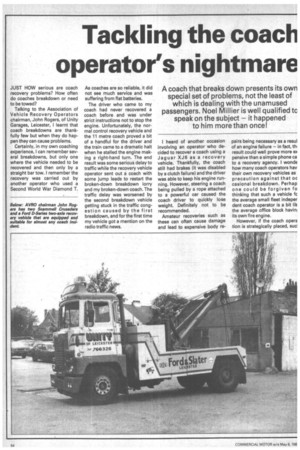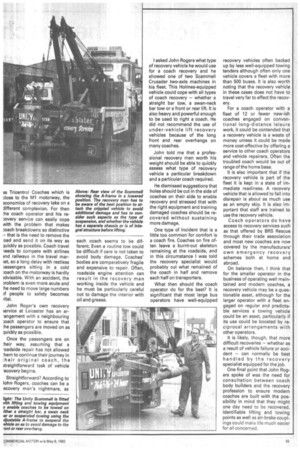• Tackling the coach operator's nightmare
Page 48

Page 49

If you've noticed an error in this article please click here to report it so we can fix it.
A coach that breaks down presents its own special set of problems, not the least of which is dealing with the unamused passengers. Noel Millier is well qualified tc speak on the subject — it happened to him more than once!
JUST HOW serious are coach recovery problems? How often do coaches breakdown or need to be towed?
Talking to the Association of Vehicle Recovery Operators chairman, John Rogers, of Unity Garages, Leicester, I learnt that coach breakdowns are thankfully few but when they do happen they can cause problems.
Certainly, in my own coaching experience, I can remember several breakdowns, but only one where the vehicle needed to be recovered and then only by a straight bar tow. I remember the recovery was carried out by another operator who used a Second World War Diamond T. As coaches are so reliable, it did not see much service and was suffering from flat batteries.
The driver who came to my coach had never recovered a coach before and was under strict instructions not to stop the engine. Unfortunately, the normal control recovery vehicle and the 11 metre coach proved a bit of a handful for the driver and the train came to a dramatic halt when he stalled the engine making a right-hand turn. The end result was some serious delay to traffic while the recovery vehicle operator sent out a coach with some jump leads to restart the broken-down breakdown lorry and my broken-down coach. The traffic delay was worsened by the second breakdown vehicle getting stuck in the traffic congestion caused by the first breakdown, and for the first time my vehicle got a mention on the radio traffic news. I heard of another occasion involving an operator who decided to recover a coach using a Jaguar XJ6 as a recovery vehicle. Thankfully, the coach still had brakes (it was disabled by a clutch failure) and the driver was able to keep his engine running. However, steering a coach being pulled by a rope attached to a powerful car caused the coach driver to quickly lose weight. Definitely not to be recommended.
Amateur recoveries such as these can often cause damage and lead to expensive body re pairs being necessary as a resul of an engine failure — in fact, th■ result could well prove more 13) pensive than a simple phone ca to a recovery agency. I won& how many coach operators hay their own recovery vehicles as precaution against that oc casional breakdown. Perhap one could be forgiven fo thinking that such a vehicle fc the average small fleet indeper dent coach operator is a bit lik the average office block havin, its own fire engine.
However, if the coach opera tion is strategically placed, sucl
as Tricentrol Coaches which is lose to the All motorway, the economics of recovery take on a different complexion. For then the coach operator and his re:overy service can easily cope Nith the problem that makes :oach breakdowns so distinctive — that is the need to remove the oad and send it on its way as quickly as possible. Coach travel ieeds to compete with airlines 3nd railways in the travel maret, so a long delay with restless Passengers sitting in a cold oach on the motorway is hardly 3dvisable. With an accident, the )roblem is even more acute and :he need to move large numbers yf people to safety becomes (ital.
John Roger's own recovery service at Leicester has an ar-angement with a neighbouring .loach operator to ensure that the passengers are moved on as quickly as possible.
Once the passengers are on their way, assuming that a -oadside repair has not allowed :hem to continue their journey in their original coach, the straightforward task of vehicle -ecovery begins.
Straightforward? According to John. Rogers, coaches can be a ecovery man's nightmare, as each coach seems to be different. Even a routine tow could be difficult if care is not taken to avoid body damage. Coaches' bodies are comparatively fragile and expensive to repair. Often, roadside engine attention can result in the recovery man working inside the vehicle and he must be particularly careful not to damage the interior with oil and grease. I asked John Rogers what type of recovery vehicle he would use for a coach recovery and he showed one of two Scammell Crusader two-axle machines in his fleet. This Holmes-equipped vehicle could cope with all types of coach recovery — whether a straight bar tow, a swan-neck bar tow or a front or rear lift. It is also heavy and powerful enough to be used to right a coach. He did not recommend the use of under-vehicle lift recovery vehicles because of the long front and rear overhangs on many coaches.
John told me that a professional recovery man worth his weight should be able to quickly assess what type of recovery vehicle a particular breakdown and a particular coach required.
He dismissed suggestions that holes should be cut in the side of coaches on their side to enable recovery and stressed that with the right equipment and training damaged coaches should be recovered without sustaining more damage.
One type of incident that is a little too common for comfort is a coach fire. Coaches on fire often leave a burnt-out skeleton remaining at the roadside, and in this circumstance I was told the recovery specialist would probably cut what remained of the coach in half and remove each half on transporters.
What then should the coach operator do for the best? It is significant that most large bus operators have well-equipped recovery vehicles often backed up by less well-equipped towing tenders although often only one vehicle covers a fleet with more than 500 buses. It is also worth noting that the recovery vehicle in these cases does not have to travel very far to effect the recovery.
For a coach operator with a fleet of 12 or fewer new-ish coaches engaged on conventional long-distance leisure work, it could be contended that a recovery vehicle is a waste of money unless it could be made more cost-effective by offering a service to other coach operators and vehicle repairers. Often the troubled coach would be out of range of the home base.
It is also important that if the recovery vehicle is part of the fleet it is kept in a state of immediate readiness. A recovery vehicle that is allowed to fall into disrepair is about as much use as an empty skip. It is also important that staff are trained to use the recovery vehicle.
Coach operators do have access to recovery services such as that offered by BRS Rescue through their trade association and most new coaches are now covered by the manufacturers' own emergency recovery schemes both at home and abroad.
On balance then, I think that for the smaller operator in the business of operating well maintained and modern coaches, a recovery vehicle may be a questionable asset, although for the larger operator with a fleet engaged on regular and predictable services a towing vehicle could be an asset, particularly if its use could be boosted by reciprocal arrangements with other operators.
It is likely, though, that more difficult recoveries — whether as a result of vehicle failure or accident — can normally be best handled by the recovery specialist equipped for the job.
One final point that John Rogers spoke of was the need for consultation between coach body builders and the recovery profession to ensure modern coaches are built with the possibility in mind that they might one day need to be recovered. Identifiable lifting and towing points as well as air-brake couplings could make life much easier for ail concerned.




























































